Across the Western United States, ranchers and land managers rely on thousands of miles of physical wire fencing to manage livestock on extensive rangelands and pastoral systems (Hayter, 1939; Netz, 2004). This type of fence has improved rangeland conditions in many places by allowing the implementation of various grazing systems (Holechek et al., 2011). However, wire fencing can fragment landscape connectivity, pose risks to wildlife, require significant financial investment, and offer little flexibility to implement adaptive management strategies (e.g., adjust pasture size, manipulate grazing distribution, limit potential for over-use, avoid sensitive habitat) within a given pasture (Jakes et al., 2018). As a result, there are management constraints when using physical fences in adaptive management systems.
Virtual fencing is an emerging precision livestock management technology that may address these limitations and potentially increase management flexibility and adaptive capacity to changing environmental conditions as part of a larger grazing management system (di Virgilio et al., 2018; Lima et al., 2018; Trotter, 2010). As a management tool, virtual fencing uses invisible barriers, established with Global Positioning System (GPS) coordinates, that influence livestock movement with a combination of auditory and electrical cues (i.e., beeping sound and electrical pulses) (Antaya et al., 2024a; Ehlert et al., 2024).The primary elements of the system are shown in Figure 1 and include (1) software to draw virtual fence (VF) lines on a digital map, which delineate where livestock should and should not be able to graze; (2) GPS-enabled collars fitted around an animal’s neck that contain technology to track livestock movement and deliver auditory and electrical cues to influence livestock distribution; and (3) base stations and/or cellular towers to transmit and receive communication between the software and collars. While there is promise for the use of VF for livestock management, there are also potential limitations. The complexities and challenges of VF are important to consider before relying on them for livestock and rangeland management. Special consideration is needed when training livestock, designing fences, managing incentives (e.g., water, nursing calves, etc.), and gathering livestock. In this fact sheet, we review the general aspects of each of these topics.
This publication is part of the Foundations of Virtual Fencing series. Other titles in this series include:
- Basics of a Virtual Fencing System
- Training and Animal Welfare
- The Vital Role of High-Quality Data
- Exploring the Complexities and Challenges
- Strategies for Collar Management
- Collar Deployment Basics
- Economics of Virtual Fencing
- Watch virtual fencing videos on Rangeland Gateway
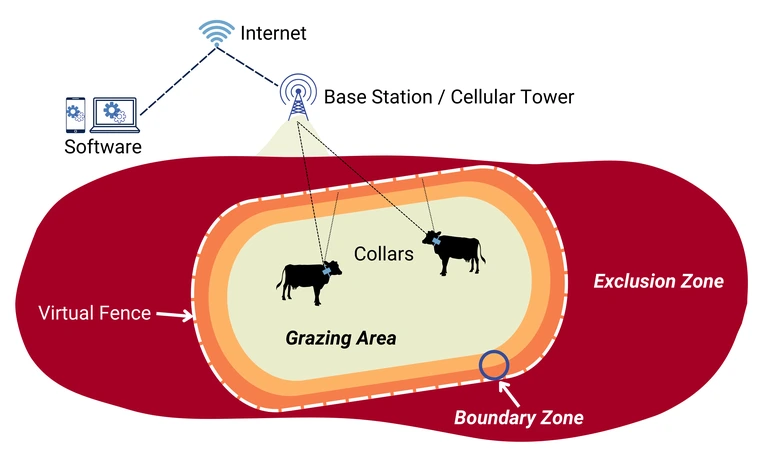
Figure 1: Conceptual model of hardware and software used to draw VF lines and define the grazing area, boundary zone, and exclusion zone
Livestock training
Training plays a fundamental role in enabling a collar to influence livestock movement. Livestock are trained to recognize an association between an auditory cue (e.g., beeping sound) and an imminent electrical cue (e.g., electrical pulse). Following training livestock are expected to respond by changing direction when they receive the auditory cue within a boundary zone, moving away from where the cue was received to avoid receiving the electrical cue (Figure 2). This learned association helps animals understand the consequences of virtual fence cues but provides limited guidance on how to direct their behavior. (for more information about the process of training and animal welfare considerations, please visit: https:// rangelandsgateway.org/virtual-fence).
When initially training livestock, it is essential to introduce them to a boundary zone where VF lines are aligned with physical fences. This controlled environment prevents inexperienced animals from crossing the boundary zone when they are first exposed to auditory and electrical cues. Each interaction with the VF prompts the animals to return to the grazing area, as they encounter a physical fence if they try to cross the boundary zone. This setup reinforces the desired behavior—returning to the grazing area—during training and can improve livestock compliance.
Compliance refers to an animal’s ability to recognize a boundary zone and exhibit the desired behavior to remain within the grazing area (Ehlert et al., 2024). Without the use of a physical fence to limit movement after a cue is applied, there is a risk that an animal might cross the VF boundary zone and enter the exclusion zone, which is the area beyond the VF boundary. In the exclusion zone, no auditory or electrical cues are provided by the collar because the animal has moved beyond the area managed by the VF. This can result in non-compliance, where the animal is either unable or unwilling to respond to cues and return to the grazing area (Ehlert et al., 2024). If livestock learn that the cues cease once they enter the exclusion zone, it may undermine the effectiveness of the VF system.
The success of training livestock for VF is enhanced through repeated interactions with a boundary zone. It is generally advisable for livestock to engage with the boundary zone multiple times during training to increase the likelihood of the desired avoidance behavior. Increasing stocking density during training can help accomplish this goal and is generally achieved by training in smaller pastures. Smaller pastures with a high perimeter-to-area ratio increase the likelihood of livestock encountering a boundary zone. The average distance from any point within a small pasture to the edge of the pasture is shorter compared to larger pastures. If the grazing area is too large, animals may spend most of their time away from the boundary zone, reducing their interactions with the VF and compromising the effectiveness of training. The effect of smaller pastures is even more pronounced in irregularly shaped pastures, which further elevate the perimeter-to-area ratio and consequently, the frequency of boundary interactions.
In cases where a small, physically fenced pasture is not available, an extended training period may be necessary to provide the herd with more opportunities to interact with the VF. While increasing the number of animals in a pasture can also boost interactions, as they will need to cover more ground in search of forage (Sawalhah et al., 2016), overstocking can negatively impact ecosystem health if supplemental feed is not provided. Additionally, if supplemental feed is required to sustain the herd during training, the associated costs should be taken into account.
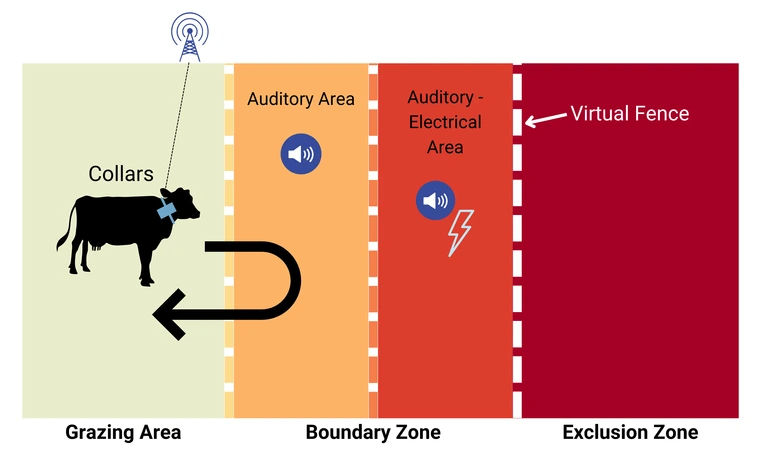
Figure 2: Classical conditioning in (a) Pavlov’s dog experiment and (b) a VF system.
Virtual fence design
Virtual fence lines are typically drawn on a satellite image or a topographic map using a smartphone, tablet, or computer. Devices available for VF creation vary depending on the VF company being used. VFs are digital lines connected by vertices, or corners, designated by geographic coordinates. When the vertices are connected, the enclosed area becomes a polygon. This polygon defines the grazing area (or an area excluded from grazing depending on the configuration of the fences and the location of livestock when fences are established). A polygon may be created in combination with or without physical fences (Figure 3).
The placement of VFs can affect how animals learn to stay within the grazing area. Placing a boundary zone near an obvious landmark or resource (e.g., water troughs, mineral supplements, corrals, and gates) may cause livestock to associate these landmarks with an electrical cue. As a result, livestock may refuse to go through a gate or approach a water source if they previously received an electrical cue in that area. To mitigate this, high-quality, accurate Geographic Information System (GIS) data are recommended for essential infrastructure and livestock resources (Antaya et al., 2024b) (for more information on GIS data needs, visit Rangeland Gatewa). It is best practice to avoid putting VFs and boundary zones within 100 ft of critical infrastructure and livestock resources to buffer against unintentional cues caused by GPS error.
When designing the layout of VFs, simple boundaries may increase the likelihood of livestock compliance (Figure 4a). A simple VF is a boundary that avoids multiple, overlapping, acute angles, and narrow passageways (e.g., hallways, lanes). Simple VFs increase the number of directions livestock can successfully move to escape a boundary zone and promotes predictability and controllability, which minimizes stressors. Because of this, multiple, overlapping, and acute angles as well as narrow passageways are not recommended when designing a VF plan, especially given GPS error (Figure 4b). In such scenarios, livestock might not effectively avoid or escape auditory and electrical cues or may mistakenly reenter a boundary zone. This confusion can lead to livestock inadvertently entering exclusion zones due to conflicting cues, thereby increasing the rate of breaches. For more complex fence designs, it is advisable to gradually introduce complexity, ensuring acute angles and overlapping fences are minimized to reduce confusion.
Additionally, managing livestock with VF requires an understanding of how the landscape might naturally constrain or influence their movement, especially when uncollared calves or unintentionally uncollared livestock exist in the herd. Placing VF lines perpendicular to draws or ravines confines movement in one direction limiting how collared animals can react when encountering a boundary zone. Calves and unmanaged animals will move directly through the boundary zone unhindered. Access to a refuge strongly influences how animals will react while experiencing acute stress (Stankowich and Blumstein, 2005). Collared animals may attempt to escape towards an uncollared group as they would do during bunching to escape biting flies (Ralley et al., 1993). This may place an animal further into the boundary zone, potentially resulting in a VF breach.
Roads and open areas present different challenges when designing VF systems. When an animal receives an electrical cue, its trained response is to turn around. The presence of an easy escape route, such as a road, can alter this behavior. Placing a VF line or corner across a road may lead to breaches, as the road offers the simplest escape route. Instead, VF lines should intersect with roads at an angle that gradually directs the animal off the road. Exploring additional factors that encourage breaches will be discussed in the next section.
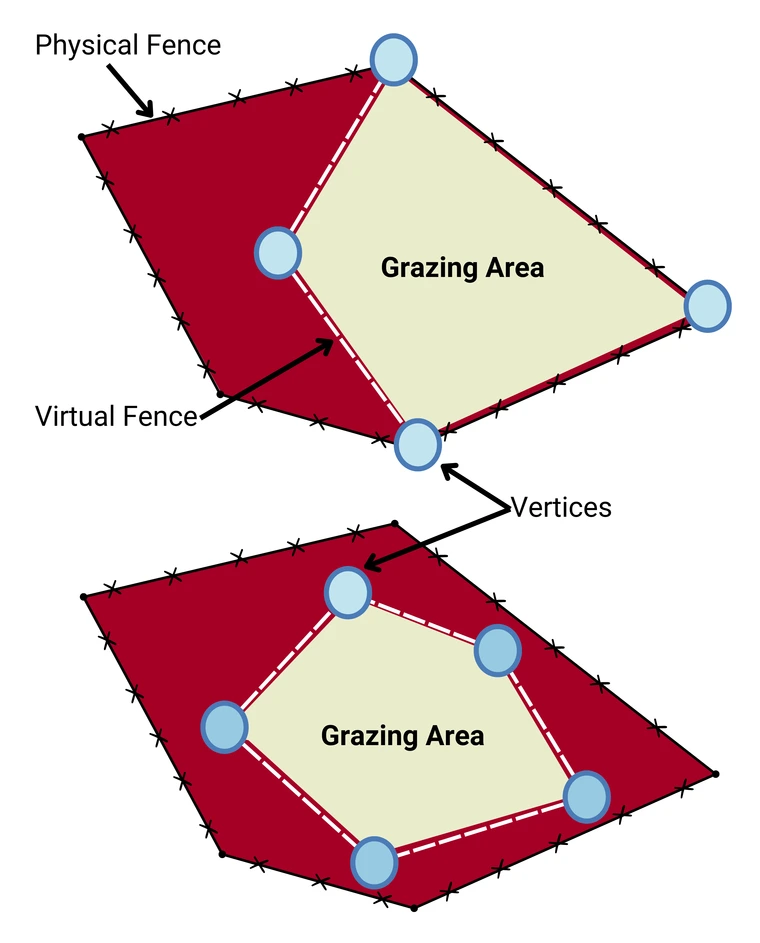
Figure 3: VF lines are joined by connecting vertices (i.e., corners) to create a polygon. The VFs can be drawn alongside physical fences or without physical fences.
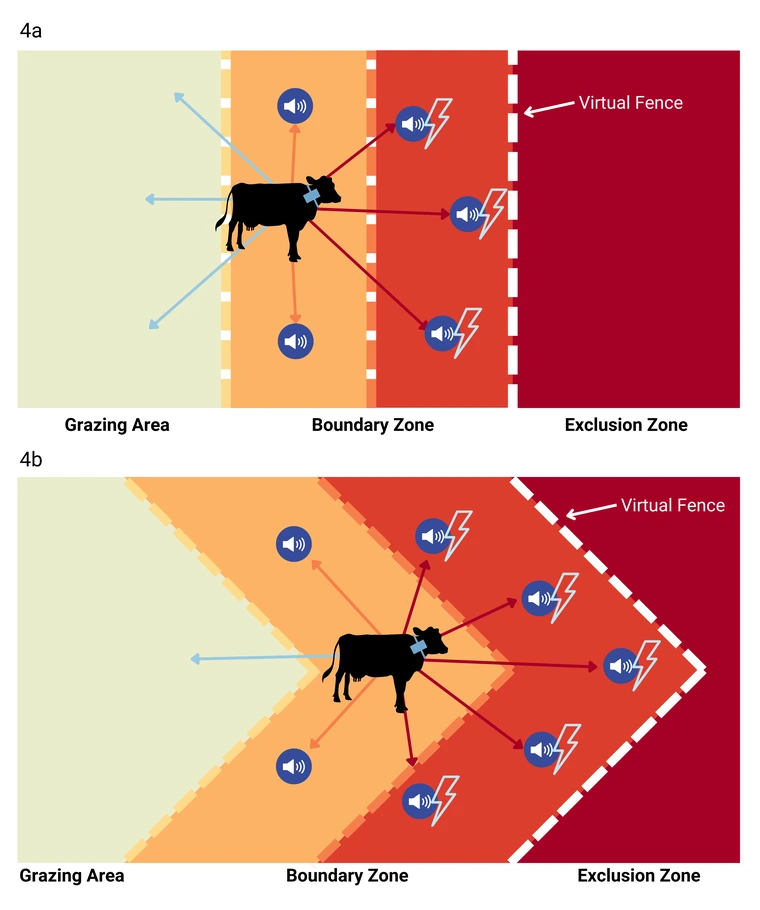
Figure 4: Conceptual model of (4a) a simple VF design where animals can more easily avoid and escape the boundary zone and (4b) a complex VF design where animals may have difficulty avoiding or escaping cues.
Managing livestock incentives
Resource and habitat preferences are well documented in livestock (El Aich and Rittenhouse, 1988; DelCurto et al., 1999; Howery et al., 1999; DelCurto et al., 2000) and they likely impact VF effectiveness and its ability to influence movement. Specific incentives (e.g., proximity to water and shade, higher quality or quantity of forage, nursing calves) may motivate non-compliant animals to breach a VF and leave a grazing area, even when the VF provides auditory and electrical cues (Figure 5). Identifying and carefully managing the distribution of incentives across a landscape in relation to VF placement may decrease the likelihood of livestock seeking incentives outside the grazing area.
Ensuring livestock have access to water and shade helps improve livestock compliance. Proximity to water is likely one of the strongest livestock incentives, especially in arid and semi-arid environments (Blackshaw and Blackshaw, 1994; Ahlberg et al., 2018). When placing VFs, the distance livestock travel daily and the distance between available waters should be considered. If distance to water is not considered, livestock may breach a VF to access a water source. Water reliability may vary across seasons and years. For example, during periods of heightened precipitation, water may be more readily available across the landscape, which may temporarily influence livestock distribution. Another incentive that could cause non-compliance is access to shaded areas suitable for thermoregulation (maintaining internal body temperature). A grazing area that includes shade or cover may reduce the incentive to access shade in more sensitive riparian habitats.
Forage availability or quality is a significant incentive for livestock to move across a pasture (Bailey, 1995). To improve compliance, consider the estimated stocking rate, quality of accessible residual forage across seasons, and quality and quantity of forage in the grazing area and exclusion zone.
Establishing a specific stocking rate for a grazing area ensures that the herd's nutritional needs are met throughout the entire grazing period, reducing the risk of livestock attempting to breach a VF.
Salt or supplements have been used to influence grazing and could help encourage livestock to remain in the grazing area even if there is additional forage in the exclusion zone (Porath et al., 2002). However, care should be taken that salt or supplements are not unintentionally left in an exclusion zone if VFs are changed. Doing so may motivate livestock to breach the VF to access them. Nutritional requirements vary among individual animals, such as pregnant cows, growing heifers or steers, and lactating cows. Depending on life stage or time of year, an animal may be more likely to breach a VF in search of higher quality or more abundant forage. When planning VF placement, it is essential to consider the herd's nutritional needs and how forage availability varies across the pasture and throughout different life stages.
Nursing calves in cow-calf operations can be a strong incentive for dams (mother cows) to disregard cues and exit the grazing area. In these operations, calves generally do not wear collars and can freely venture into a boundary or exclusion zone. Proximity to the calf may incentivize dams to enter or breach a boundary zone despite cues. Over time, this will reduce the effectiveness of the VF system (Boyd et al., 2023). While managing these scenarios is challenging, the development of thoughtful fence design and sustainable stocking rates can help minimize opportunities for dams and their calves to interact with the fence line.
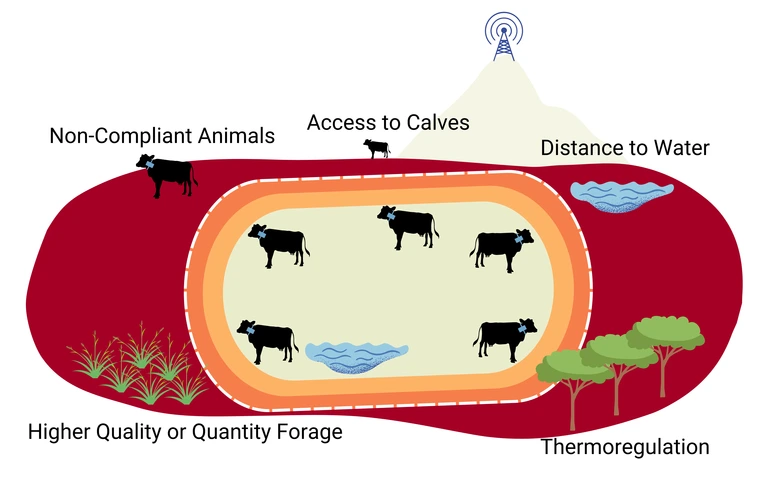
Figure 5. Types of incentives that may motivate livestock to leave the grazing area despite the VF system. Incentives include higher forage quality or quantity, noncompliant animals, access to calves, distance to water, and areas for thermoregulation. There are likely other unknown incentives not pictured.
Gathering livestock with passive capture
Proactive planning is needed when gathering livestock while VFs are active. If VF boundaries are left active, livestock may inadvertently enter boundary zones and receive cues when being moved by ranchers. To avoid these unintended cues, turn off fences or deactivate cues in advance of moving livestock between pastures. It may take up to three days for collars to receive updates depending on factors such as collar location related to topographic influences, tree cover density, GPS accuracy, and cellular coverage once updates are initialized. VFs should not be expected to instantly activate or deactivate boundaries to immediately manage livestock. The actual times required for activation and deactivation may vary between VF companies, based on the topography of a specific ranch, and products as new versions are released.
A VF system can enhance traditional gathering techniques by leveraging the virtual fence’s one way functionality. VF systems are designed so livestock only receive auditory and electrical cues when they approach a boundary zone. Non-compliant animals, (e.g., those that have left the grazing area), can cross through the VF back into the grazing area without receiving cues.
This same functionality can be used to passively capture livestock, or group animals into a specific, desired area (e.g., near a gate), as they move within a pasture (Figure 6).
Incentives can be instrumental to passive capture strategies. For example, if multiple pastures share a water source, livestock can move to a new grazing area with a higher abundance of forage or available supplement/salt after accessing water. Maximizing livestock incentives in a new grazing area can improve passive capture success and can assist with traditional gathering techniques.
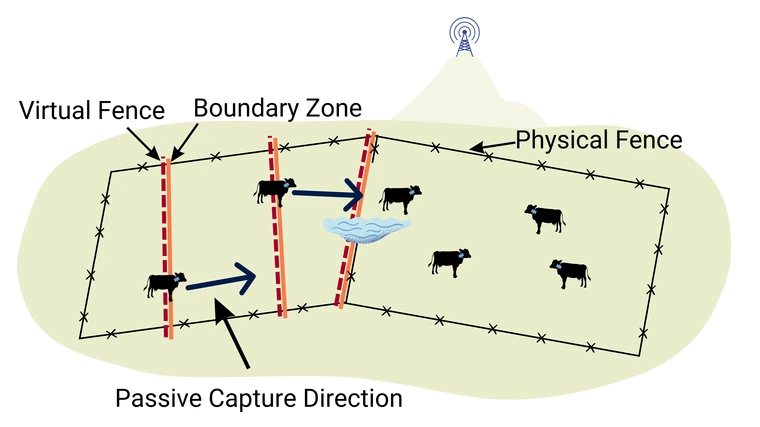
Figure 6. Conceptual model of a VF system used to influence livestock movement with passive capture. Virtual fence lines only deliver cues when animals attempt to enter an exclusion zone. This one-way functionality allows livestock to be grouped into a specific area based on their movements alone.
Conclusion
Virtual fence technology presents a promising solution to the challenges posed by traditional wire fencing for managing livestock on extensive rangelands. While physical fences have played a crucial role in implementing grazing systems, they come with limitations such as landscape fragmentation and a lack of flexibility. Though VF systems have upfront and recurring costs, they may also offer some ranchers increased flexibility and adaptability to changing environmental conditions. As technologies evolve and more vendors come to the market, prices typically decrease. Current VF technology is not capable of completely replacing all wire fences, especially boundary fences, or human labor.
The successful implementation of VF technology hinges on careful planning, effective livestock training, thoughtful fence design, management of incentives, and strategic livestock movement. Training livestock to associate auditory cues with electrical cues is essential for ensuring that livestock can recognize and respond in the desired way to invisible boundaries. This training is most effective in controlled environments that account for stocking density, topography, and pasture size and shape. The design and placement of virtual fences require careful consideration to optimize compliance. Simple VF designs are likely more effective, minimizing stress on livestock, while avoiding complex configurations and acute angles that may lead to confusion and unintentional breaches. Thoughtful placement, considering landmark associations and using accurate Geographic Information System (GIS) data further contribute to the reliability of virtual fences.
The management of incentives is crucial to reduce the likelihood of livestock seeking incentives outside of a grazing area. Strategic use of passive capture techniques, leveraging water sources and additional incentives (e.g. salt or supplement), enhances traditional gathering methods. Proactive planning, in-depth understanding of the specifics of a livestock operation, knowledge of virtual fence locations, and deactivation or removal of cues help avoid unintended cues and livestock stress during rotations. When implemented thoughtfully and in conjunction with sustainable livestock management practices, VF has the potential to fundamentally change rangeland management by offering ranchers a more flexible and adaptive approach to livestock grazing.
Disclaimer
There are several companies that manufacture hardware and software including eShepherd™, Halter™, Nofence™, and Vence™. Virtual fencing components from different manufacturers are generally not interoperable or interchangeable. Specific components, GIS data needs, software protocol, software training, frequency and duration of the cues, GPS error, livestock collaring, and livestock training protocols may vary depending on the manufacturer. Follow the manufacturer’s recommendations and guidelines. The University of Arizona does not endorse a specific product.
Acknowledgements
This material is based upon work that is supported by the National Institute of Food and Agriculture, U.S. Department of Agriculture, under award number 2021- 38640-34695 through the Western Sustainable Agriculture Research and Education program under project number WPDP22-016. USDA is an equal opportunity employer and service provider. Any opinions, findings, conclusions, or recommendations expressed in this publication are those of the author(s) and do not necessarily reflect the view of the U.S. Department of Agriculture.
This work is supported by the AFRI Foundational and Applied Science Program: Inter-Disciplinary Engagement in Animal Systems (IDEAS) [Award no. 2022-10726] from the USDA National Institute of Food and Agriculture.
Additional funding for the University of Arizona’s Virtual Fence program was provided by Arizona Experiment Station, the Marley Endowment for Sustainable Rangeland Stewardship, Arizona Cooperative Extension, and The Nature Conservancy.
For additional information about virtual fence, visit: https://rangelandsgateway.org/virtual-fence
References
Antaya, A.M., Dalke, A., Mayer, B., Noelle, S., Beard, J., Blum, B., Ruyle, G., Lien, A., 2024. What is virtual fence? Basics of a virtual fencing system (No. az2079). University of Arizona Extension Publication az2079, Tucson, Arizona, USA. https://extension.arizona.edu/sites/extension.arizona.edu/files/pubs/az2079-2024.pdf.
Antaya, A.M., Dalke, A., Mayer, B., Blum, B., Beard, J., Blouin, C., Noelle, S., Ruyle, G., Lien, A., 2024. Foundations of Virtual Fencing: The Vital Role of High-Quality GIS Data (No. az2087). University of Arizona Extension Publication az2087, Tucson, Arizona, USA. https://extension.arizona.edu/sites/extension.arizona.edu/files/pubs/ az2087-2024.pdf.
Bishop-Hurley, G.J., Swain, D.L., Anderson, D.M., Sikka, P., Crossman, C., Corke, P., 2007. Virtual fencing applications: Implementing and testing an automated cattle control system. Computers and Electronics in Agriculture 56, 14– 22. https://doi.org/10.1016/j.compag.2006.12.003
Brown, E.J., Vosloo, A., 2017. The involvement of the hypothalamopituitary-adrenocortical axis in stress physiology and its significance in the assessment of animal welfare in cattle. Onderstepoort Journal of Veterinary Research 84, 9. https://doi.org/10.4102/ojvr.v84i1.1398
Cafe, L.M., Robinson, D.L., Ferguson, D.M., McIntyre, B.L., Geesink, G.H., Greenwood, P.L., 2011. Cattle temperament: Persistence of assessments and associations with productivity, efficiency, carcass and meat quality traits. Journal of Animal Science 89, 1452–1465. https://doi.org/10.2527/jas.2010-3304
Campbell, D.L.M., Lea, J.M., Keshavarzi, H., Lee, C., 2019. Virtual Fencing Is Comparable to Electric Tape Fencing for Cattle Behavior and Welfare. Frontiers in Veterinary Science 6.
Chen, Y., Arsenault, R., Napper, S., Griebel, P., 2015. Models and methods to investigate acute stress responses in cattle. Animals 5, 1268–1295.
Cooke, R.F., 2014. Bill E. Kunkle Interdisciplinary Beef Symposium: Temperament and acclimation to human handling influence growth, health, and reproductive responses in Bos taurus and Bos indicus cattle. Journal of Animal Science 92, 5325–5333. https://doi.org/10.2527/jas.2014-8017
di Virgilio, A., Morales, J.M., Lambertucci, S.A., Shepard, E.L., Wilson, R.P., 2018. Multi-dimensional Precision Livestock Farming: A potential toolbox for sustainable rangeland management. PeerJ 6, e4867.
Dobson, H., Smith, R.F., 2000. What is stress, and how does it affect reproduction? Animal reproduction science 60, 743–752.
Dobson, H., Tebble, J.E., Smith, R.F., Ward, W.R., 2001. Is stress really all that important? Theriogenology 55, 65–73.
Domjan, M.P., 2014. The principles of learning and behavior. Cengage Learning.
Ehlert, K.A., Brennan, J., Beard, J., Reuter, R., Menendez, H., Vandermark, L., Stephenson, M., Hoag, D., Meiman, P., O'Connor, R.C. and Noelle, S., 2024. What's in a Name? Standardizing Terminology for the Enhancement of Research, Extension, and Industry Applications of Virtual Fence Use on Grazing Livestock. Rangeland Ecology & Management, 94, pp.199-206.
Fernandez-Novo, A., Pérez-Garnelo, S.S., Villagrá, A., Pérez-Villalobos, N., Astiz, S., 2020. The effect of stress on reproduction and reproductive technologies in beef cattle—A review. Animals 10, 2096.
Hayter, E.W., 1939. Barbed Wire Fencing: A Prairie Invention: Its Rise and Influence in the Western States. Agricultural History 13, 189–207.
Holechek, J., Pieper, R.D., Herbel, C.H., 2011. Range management: principles and practices. Prentice Hall,.
Jakes, A.F., Jones, P.F., Paige, L.C., Seidler, R.G., Huijser, M.P., 2018. A fence runs through it: A call for greater attention to the influence of fences on wildlife and ecosystems. Biological Conservation 227, 310–318. https://doi.org/10.1016/j.biocon.2018.09.026
Kumar, B., Manuja, A., Aich, P., 2012. Stress and its impact on farm animals. FBE 4, 1759–1767. https://doi.org/10.2741/e496
Langworthy, A.D., Verdon, M., Freeman, M.J., Corkrey, R., Hills, J.L., Rawnsley, R.P., 2021. Virtual fencing technology to intensively graze lactating dairy cattle. I: Technology efficacy and pasture utilization. Journal of Dairy Science 104, 7071–7083. https://doi.org/10.3168/jds.2020-19796
Lee, C., Colditz, I.G., Campbell, D.L.M., 2018. A Framework to Assess the Impact of New Animal Management Technologies on Welfare: A Case Study of Virtual Fencing. Frontiers in Veterinary Science 5.
Lee, C., Henshall, J.M., Wark, T.J., Crossman, C.C., Reed, M.T., Brewer, H.G., O’Grady, J., Fisher, A.D., 2009. Associative learning by cattle to enable effective and ethical virtual fences. Applied Animal Behaviour Science 119, 15–22. https://doi.org/10.1016/j.applanim.2009.03.010
Lima, E., Hopkins, T., Gurney, E., Shortall, O., Lovatt, F., Davies, P., Williamson, G., Kaler, J., 2018. Drivers for precision livestock technology adoption: A study of factors associated with adoption of electronic identification technology by commercial sheep farmers in England and Wales. PloS one 13, e0190489.
Moberg, G.P., 1985. Influence of Stress on Reproduction: Measure of Well-being, in: Moberg, G.P. (Ed.), Animal Stress. Springer, New York, NY, pp. 245–267. https://doi.org/10.1007/978-1-4614-7544-6_14
Netz, R., 2004. Barbed wire: An ecology of modernity. Wesleyan University Press.
Ray, E., Schamel, W., 1997. Glidden’s Patent Application for Barbed Wire. Social Education 61, 53–56.
Selye, H., 1976. Stress without Distress, in: Serban, G. (Ed.), Psychopathology of Human Adaptation. Springer US, Boston, MA, pp. 137–146. https://doi.org/10.1007/978-1-4684-2238-2_9
Trotter, M., 2010. Precision agriculture for pasture, rangeland and livestock systems, in: Food Security from Sustainable Agriculture 15th Australian Agronomy Conference, Lincoln, New Zealand.
Umstatter, C., 2011. The evolution of virtual fences: A review. Computers and Electronics in Agriculture 75, 10–22. https://doi.org/10.1016/j.compag.2010.10.005
Umstatter, C., Morgan-Davies, J., Waterhouse, T., 2015. Cattle Responses to a Type of Virtual Fence. Rangeland Ecology & Management 68, 100–107. https://doi.org/10.1016/j.rama.2014.12.004
Verdon, M., Langworthy, A., Rawnsley, R., 2021. Virtual fencing technology to intensively graze lactating dairy cattle. II: Effects on cow welfare and behavior. Journal of Dairy Science 104, 7084–7094. https://doi.org/10.3168/jds.2020-19797
von Borell, E., Dobson, H., Prunier, A., 2007. Stress, behaviour and reproductive performance in female cattle and pigs. Hormones and Behavior, Reproductive Behavior in Farm and Laboratory Animals 52, 130–138. https://doi.org/10.1016/j.yhbeh.2007.03.014

